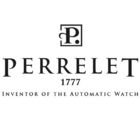Perrelet: Difference between revisions
No edit summary |
|||
| (2 intermediate revisions by the same user not shown) | |||
| Line 1: | Line 1: | ||
[[File:Perrelet.jpg|thumb]] | [[File:Perrelet.jpg|thumb]] | ||
==Perrelet== | |||
Festina acquired in 2004 the luxury watch brand Perrelet, founded in 1777 by the prestigious watchmaker Abraham-Louis Perrelet. | |||
==History== | |||
Abraham-Louis Perrelet, (9 January 1729 – 1826), born in Neuchâtel in Switzerland, was a Swiss horologist. | |||
His father, Daniel was a carpenter and a farmer and as soon as the young man was in a position to do some favours, he helped his parents on the farm. At the age of twenty years he gave up his modest work to learn watchmaking. After an apprenticeship of fifteen days at one named Prince, in Le Locle, who worked little and very badly, and where he learnt absolutely nothing, he started to work independently and so became his own master. | |||
In 1777, Perrelet invented a self-winding mechanism for automatic watches. It worked on the same principle as a modern wristwatch, and was designed to wind as the owner walked, using an oscillating weight inside the large watch that moved up and down. | |||
The Geneva Society of Arts reported in 1777 that fifteen minutes walking was necessary to wind the watch sufficiently for eight days, and the following year reported that it was selling well. Perrelet is thus widely acknowledged as the inventor of the "automatic" watch. However, his watch probably used a weight pivoting at the side of the movement. | |||
Perrelet sold some of his watches to a contemporary watchmaking luminary, Abraham-Louis [[Breguet]] around 1780, who improved upon the mechanism in his own version of the design, calling his watches "perpetuelles", the French word for perpetual. They did not work reliably and Breguet stopped producing them around 1810. | |||
While the factory claims to have been in continuous production since the late eighteenth century, the brand has only recently begun to command attention worthy of its heritage. The brand, acquired in 2004 by Miguel Rodriguez of the [[Festina]] Group, appointed Marc Bernhardt as CEO of Perrelet in 2007, and under his direction the company released a few highly regarded watches. These included watches with retrograde, jumping hour, and double-rotor complications. | |||
==Links== | ==Links== | ||
*[[Switzerland]] | *[[Switzerland]] | ||
*[[Festina]] | |||
*[[Spain]] | |||
*[[Main Page]] | *[[Main Page]] | ||
*[[History of Watches]] | *[[History of Watches]] | ||
Latest revision as of 19:50, 16 April 2020

Perrelet
Festina acquired in 2004 the luxury watch brand Perrelet, founded in 1777 by the prestigious watchmaker Abraham-Louis Perrelet.
History
Abraham-Louis Perrelet, (9 January 1729 – 1826), born in Neuchâtel in Switzerland, was a Swiss horologist. His father, Daniel was a carpenter and a farmer and as soon as the young man was in a position to do some favours, he helped his parents on the farm. At the age of twenty years he gave up his modest work to learn watchmaking. After an apprenticeship of fifteen days at one named Prince, in Le Locle, who worked little and very badly, and where he learnt absolutely nothing, he started to work independently and so became his own master.
In 1777, Perrelet invented a self-winding mechanism for automatic watches. It worked on the same principle as a modern wristwatch, and was designed to wind as the owner walked, using an oscillating weight inside the large watch that moved up and down. The Geneva Society of Arts reported in 1777 that fifteen minutes walking was necessary to wind the watch sufficiently for eight days, and the following year reported that it was selling well. Perrelet is thus widely acknowledged as the inventor of the "automatic" watch. However, his watch probably used a weight pivoting at the side of the movement.
Perrelet sold some of his watches to a contemporary watchmaking luminary, Abraham-Louis Breguet around 1780, who improved upon the mechanism in his own version of the design, calling his watches "perpetuelles", the French word for perpetual. They did not work reliably and Breguet stopped producing them around 1810.
While the factory claims to have been in continuous production since the late eighteenth century, the brand has only recently begun to command attention worthy of its heritage. The brand, acquired in 2004 by Miguel Rodriguez of the Festina Group, appointed Marc Bernhardt as CEO of Perrelet in 2007, and under his direction the company released a few highly regarded watches. These included watches with retrograde, jumping hour, and double-rotor complications.
